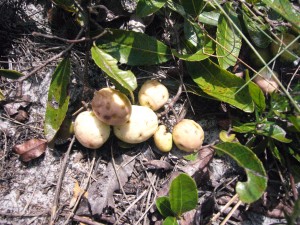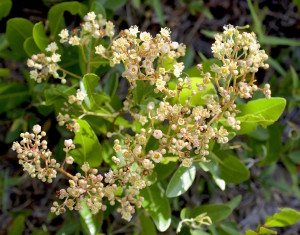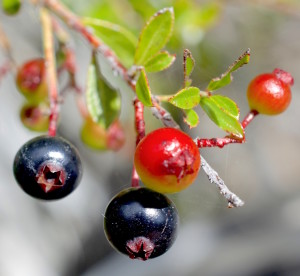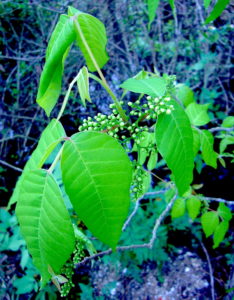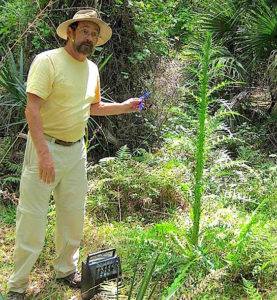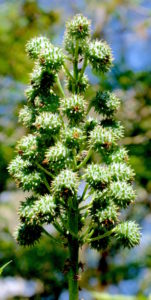Gopher apples don’t travel well. In fact, Gopher apples don’t look well, either. About the size and shape of a large olive they are pink, pasty, soft and best eaten right off the bush. Don’t put them in your pocket!
The Gopher Apples were blossoming abundantly this past weekend during a foraging class in Melbourne (Fl.) That seems to me to be a little late in the season but perhaps the lack of usual rain has altered their schedule. It’s not unusual in most years to find edible Gopher Apple by this time of year. The Melbourne location has one other odd aspect regarding Gopher Apples. Usually they are six inches to perhaps a foot high, often very low growing looking like a patch of mowed young oaks. However I have seen Gopher Apples at the Melbourne location easily over two feet high. It is the only place I have seen Gopher Apples that tall. Perhaps certain conditions facilitate that. You can read more about Gopher Apples here.
Blueberry season is also something of a mystery this year. By now one usually finds ripe Deer Berries. (That link to an old newsletter also has a good breakdown of local Vaccinums.) For at least six weeks I’ve been seeing unripe blueberries but no flush of ripe ones yet. Usually the progression is consistent and rapid. It’s almost as if the blueberries are waiting to ripen. Again, varying amounts of rainfall might have some influence on that. Places that I usually find abundant with ripe berries this time of year are still a week or two from being ripe. And don’t forget that blueberries like acidic soil which is not a problem in northern states but an issue in Florida which is essentially a limestone plate. Thus locally one looks for them in association with oaks and pines. While cypress also create an acid environment it is also usually too wet for blueberries to grow near cypress. You can read about Blueberries here and Huckleberry kin here.
We also saw our first Tallow Plum approaching ripeness this season. Tallow Plums favor late spring and summer but they can also linger into the fall. Sometimes you can find one even in winter. This time of year most of the fruit looks like a skinny green olive. But soon they will plum out to about a ping pong ball size and turn bright yellow. They can also be fairly long blooming so the fruiting season can be many months. The species seem to be more common along the coasts but I have found one shrub just west of Orlando. While the fruit poses few questions to foragers botanists are still a bit baffled. When you find Tallow Plum shrubs is it many different shrubs or just one clone popping out of the ground in many places? And is it a stand-alone plant or semi-parasitic? While they try to work out those problems we can just eat it. You can read more about Tallow Plums here.
And…. I do believe I have a case of Poison Ivy. If so it’s only the third time in my life so I can’t complain (considering I am in wild plants nearly everyday.) I’m usually good at spotting it first but this past Saturday I reached before I looked closely and when I glanced back I wondered if I brushed the poison
ivy with my right forearm. It would seem I did. It took about 80 hours for it to manifest itself with itching and weeping at the same time. Seems to be isolated. If not you’ll hear about it. I put on a little 1% hydrocortisone cream (with aloe.) Washing immediately after contact with a non-oil based soap/detergent is the best counter measure. Clean like it is black bike chain grease…. of course you have to know you touched it. I was teaching a class at the time and shrugged it off. Fundamentally everyone will get Poison Ivy if they keep getting exposed to it. The most common horror story I hear is from folks who thought they were immune because over many years of touching it they had no problem. Those are the folks who do it one time too many and end up in the hospital. Everyone is born with a different resistant to Poison Ivy and each exposure reduces the resistance. It will happen if you keep messing with it. Interestingly only three groups get Poison Ivy; humans, some monkeys and guinea pigs. They are also the only three that cannot make their own vitamin C. Odd how that works out. You can read about Poison Ivy here.
FORAGING CLASSES: Heading way south this Saturday for a foraging class in West Palm Beach. Dreher Park is interesting in that it is far enough south to have some tropicals resistant to cooler temperatures. We should find ripe cocoplums and can also leave the park briefly and see a cashew tree.
Saturday, May 20th, Dreher Park, 1200 Southern Blvd., West Palm Beach, 33405. We meet just north of the science center in the northern part of the park. 9 a.m.
Saturday, May 27th, Boulware Springs Park, 3420 SE 15th St., Gainesville, FL 32641. 9 a.m. Meet next to the spring house.
Sunday, June 4th, John Chestnut County Park: 2200 East Lake Road, Palm Harbor, FL 9 a.m. 34685.
Sunday, June 11th, Bayshore Live Oak Park, Bayshore Drive. Port Charlotte. 9 a.m. Meet at the parking lot at the intersection of Bayshore Road and Ganyard Street.
Saturday, June 17th, Florida State College, south campus, 11901 Beach Blvd., Jacksonville, 32246. 9 a.m.
Sunday, June 18th, Blanchard Park, 10501 Jay Blanchard Trail, Orlando, FL 32817. 9 a.m. Meet east side of the tennis courts near the YMCA building.
To read more about the foraging classes go here.
Want to identify a plant? Looking for a foraging reference? Do you have a UFO, an Unidentified Flowering Object you want identified? On the Green Deane Forum we chat about foraging all year. And it’s not just about warm-weather plants or just North American flora. Many nations around the world share common weeds so there’s a lot to talk about. There’s also more than weeds. The reference section has information for foraging around the world. There are also articles on food preservation, and forgotten skills from making bows to fermenting food. One special section is “From the Frightening Mail Bag” where we learn from people’s mistakes. You can join the forum by clicking on the button on the upper right hand side of this page.
Spring orders have started their annual increase. All of Green Dane’s videos available for free on You Tube. They do have ads on them so every time you watch a Green Deane video I get a quarter of one cent. Four views, one cent. Not exactly a large money-maker but it helps pays for this newsletter. If you want to see the videos without ads and some in slightly better quality you can order the DVD set. It is nine DVDs with 15 videos on each. Many people want their own copy of the videos or they have a slow service and its easier to order then to watch them on-line. They make a good gift for that forager you know. Individual DVDs can also be ordered. You can order them by clicking on the button on the top right of this page or you can go here.
From the Archives: Blue Porterweed
Do you like mushrooms but want to avoid some of dangers that come with fungi foraging? Then there is a subtle solution: Blue Porterweed.
Found in flower gardens around the world and native to Florida the Blue Porterweed earned its name as a source for tea that tastes like porter beer. Someone had the fermenting idea to add yeast and sugar to a lot of tea and get a brew that tastes similar to the beer, hence the name. The flower garden variety usually grows up and the local native grows horizontally. Both are forager friendly. The blue flowers, raw, have a subtle flavor of mushrooms. You can read more about the Blue Porterweed here. Oh, and how did porter beer get its name? The same way porter steak did. Porters — baggage handles in old central London — worked all hours and needed quick food. Shops set up to meet that need and out of them came several dishes and named items.
This is issue 257
If you would like to donate to Eat The Weeds please click here.

